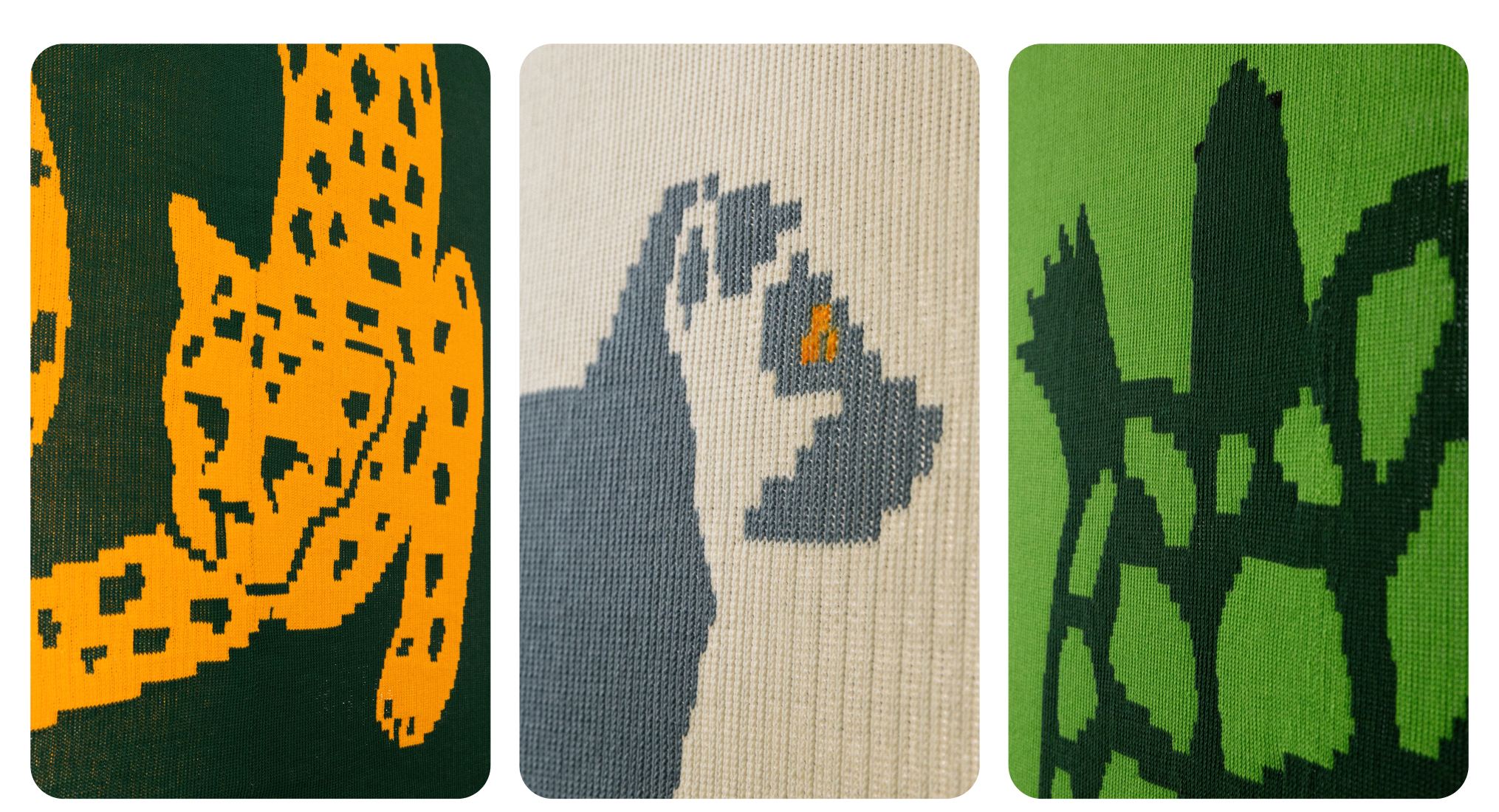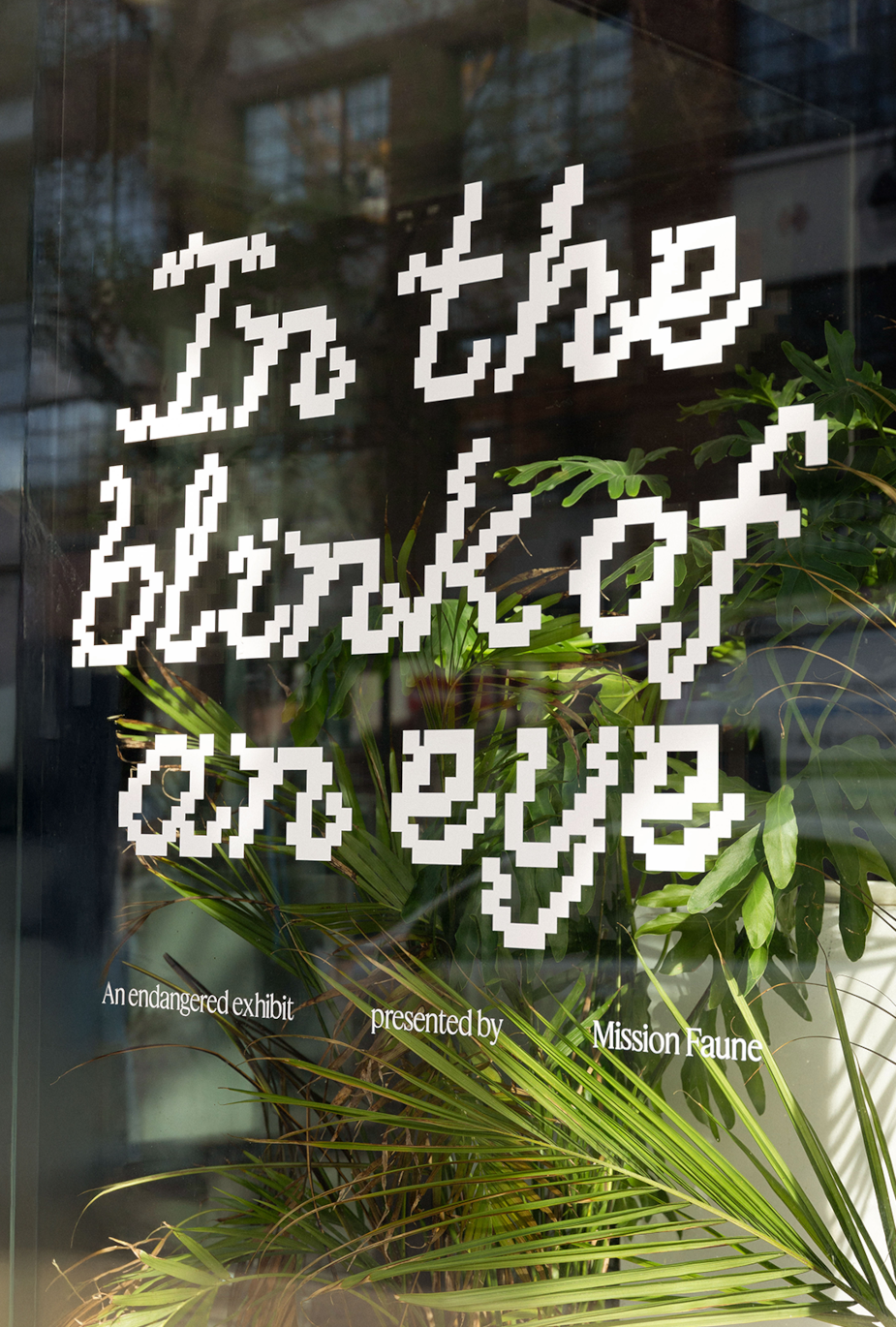
Behind the Biodiversity Campaign That Destroyed Itself in the Blink of an Eye

According to the Quebec-based Zoo de Granby, at the moment, an estimated one million (out of eight million) animal species on the planet are considered threatened, while 50% of Canadian species are thought to be in decline. Those are pretty grim statistics, to put it lightly. It’s clear the Earth’s biodiversity and ecosystems are struggling, and that human behaviours and choices are the driving factors behind this trajectory.
Unfortunately, at this point, merely being concerned is no longer enough. The time for action is now – something which the zoo, alongside its creative agency, LG2, decided to emphasise on Earth Day last month with a campaign calling out the fact that inactivity and apathy are not adequate responses. Specifically, to highlight this, the two interpreted the message literally, creating custom-designed, knitted woolen tapestries which, when spectators blinked, would unravel in their faces. Depicting three beloved but endangered species – a turtle, a jaguar and a lemur – each was created by artist Lysanne Latulippe, and gave way to an unexpectedly short yet poignant exhibition with a hard-to-miss point.
To learn more about the work, the technology driving it, and why this was the right way to draw attention to the importance of engaging in the fight for biodiversity preservation, LBB’s Jordan Won Neufeldt sat down with LG2 partner and executive creative director Geneviève Langlois, as well as Zoo de Granby’s director of philanthropic development, partnerships and sponsorships, Marie-Claude Landry, for a chat.
LBB> Drawing attention to the state of biodiversity preservation in a meaningful way is no small task. As such, what was the brief for this, and what immediate ideas came to mind?
Marie-Claude> LG2 is a long-standing partner of Zoo de Granby, and was the driving force behind the campaign that launched the ‘Mission Faune’ movement in May 2024. So, going into this, once the Mission Faune Zoo de Granby Foundation had clearly defined its objectives – reflect the Foundation’s priorities clearly through a campaign – LG2 became involved from the start of that process.
Geneviève> We had to get the word out about Mission Faune, its mission, and its commitments, in order to convince Quebecers to join the movement. As North Americans, biodiversity – and wildlife in particular – aren't things we're exposed to on a regular basis. We're not confronted with these topics in our day-to-day lives, which means they don't necessarily come up in conversation. And that’s where our inaction comes in.
With that in mind, we had to remind Quebecers that because of human activities and its harmful impact on the environment, thousands of wild species are disappearing every day, all while our inaction only exacerbates the problem. We knew we had to elicit strong emotions to touch the public’s heart and convey a sense of urgency. This is also why we focused on wild animals rather than the more abstract concepts of biodiversity or climate change. We needed to put a face on the problem, and animals have the natural ability to evoke empathy and compassion.
LBB> Tell us more about the Foundation. What should people know about you and your flagship commitment, and why was this campaign right for your organisation?
Marie-Claude> For more than 30 years, the Mission Faune Zoo de Granby Foundation has prioritised the funding and promotion of initiatives and projects that protect the animal world. We work closely with the experts at the Société Zoologique de Granby to ensure the success of our educational, conservation and research projects. We continually seek to highlight the role humans can play in their environment and how they can be agents of positive change.
LBB> Research-wise, what sort of insights helped shape the creative? And as a whole, what was the ideation process like?
Marie-Claude> Biodiversity refers to all living marine and aquatic beings, as well as the ecosystems in which they live and interact. It plays an essential role in maintaining life on Earth, and contributes directly to human wellbeing. This balance is an invaluable asset that must be recognised and protected, and was the main insight LG2 built around.
Geneviève> We wanted to illustrate the fragility of the situation, and the fact that by closing our eyes, we’re contributing to making it worse. That’s how we came up with the idea of creating an exhibition as ephemeral as endangered species. In fact, it’s probably the shortest ephemeral exhibition of all time!
We wanted to convey the idea that the more you close your eyes, the more things disappear. This also underscored Mission Faune's role in opening Quebecers' eyes to the problem. So, we created a technology that made animals disappear when people closed their eyes – something we already do naturally without realising it. This led people to do the one thing nobody should ever do in a museum: destroy the work.

LBB> Strategically, where does one begin when planning for an endeavour such as this? How did the process compare to a more traditional execution, and at what point did you even know this would be feasible?
Geneviève> A rich culture of diverse expertise at LG2 contributes to the openness, curiosity and solution-oriented approach of our teams. We never go into a project thinking it can’t be done.
In this case, since Mission Faune is a driver of change, one of our biggest concerns was the importance of not creating waste… which made wool the obvious choice of material. Simultaneously ecological, precious and fragile, we knew it could be reused afterwards. In fact, sweaters made from the wool used in the pieces are currently being created and will be auctioned off to raise funding for animal research and conservation.
LBB> The tech behind the installation also looks super cool! On a practical level, how does it work, and how did you create it?
Geneviève> Technologically, the challenge was to associate several mechanisms with the specific action of closing your eyes – something which would instantly trigger a chain reaction that destroyed the piece.
Of course, it was important that the work unravel fast enough to elicit a shock reaction in the blink of an eye. To do this, we had to get people to stand at just the right distance from the camera so that the facial recognition software could detect their eye movements. The camera was connected to a winder that was modified to unravel the pieces. It would activate in sync with the camera as soon as a participant closed their eyes.

LBB> Equally important are the designs themselves. What sort of influences drove the final art, and what made depicting the jaguar, the lemur and the turtle right for this creative?
Marie-Claude> We wanted to highlight endangered species that we’re directly involved in protecting. For example, we’re carrying out recovery projects for various species of turtles, collecting their eggs from the banks of rivers in Montérégie and the Eastern Townships. These eggs are incubated in the laboratory until they hatch, after which the young turtles are reintroduced into their natural habitat once they’re strong enough.
Geneviève> We also carried out a survey to find out which animals generated the biggest reactions when people thought about them becoming extinct.
As for the designs, the illustrative style was influenced by vintage knitting patterns. We wanted a style that was somewhere between realistic and playful, so that a wide audience would feel attached to the animals. Simple two-tone silhouettes make the work instantly recognisable and ideal for the craft of knitting.

LBB> To do this, you worked with Lysanne Latulippe. What was that collaboration like, and why was she the right person for the job?
Geneviève> Obviously, she’s really talented. Not only did we need someone with both the artistic and technical skills to create these three pieces, but the result needed to be able to gradually deconstruct throughout the day, without falling apart immediately.
Also, like all the talents on this project, Lysanne cared. She tried many methods before finding the right one. She made sure her work was not only as aesthetically pleasing as possible, but also as fragile as possible. And she had fun doing it. She listened and understood the goal and the feeling we wanted to create.
LBB> How did things go on the actual day of the showcase? Practically speaking, how did you ensure this campaign got maximum eyeballs, and how did people respond?
Geneviève> We were on site a few days beforehand. Then, after installation, we sent out invitations and the gallery announced the exhibition… but nobody knew what they were about to experience.
The show was held in a gallery on a busy street, on a Thursday when we knew Montrealers would be out in force. Initially seduced by the pieces, everyone immediately wanted to step away from the work when they realised their actions had played a part in its destruction. They all truly felt bad and noted that it made them think about the impact of their inaction.

LBB> As a whole, what challenges came with this project, and how did you overcome them?
Marie-Claude> For us, the main challenge was getting the message across in a short period of time. However, once we were sure LG2 understood the campaign objectives, we trusted them fully to generate the idea and execute the creative assets.
Geneviève> Many tests needed to be done beforehand. We needed to find the right speed for the wool winder, the correct height for the camera, the right software to use, create the perfect frames to hold the canvas without causing the wool to get tangled, etc. Everything needed to be perfect because we knew that on the day of, we’d only have one chance for each piece.
While we often work with digital assets, where we can edit things, redo them, and try different versions, on the other hand, wool is highly tangible. It tangles and folds in places you don’t want it to. It’s delicate. It’s what brought a lot of charm and sensibility to the
project... but also a lot of headaches, haha.
LBB> Since launch, how have people responded to this campaign?
Marie-Claude> The reception has been very positive, and the teams are proud to be associated with it. We’ve already received many touching comments from the public, who’ve expressed that they were deeply moved by the video.
We’re also seeing great mobilisation on our social platforms and growing interest in Mission Faune, which bodes well for a lasting impact. Not only that, but this initiative has strengthened the sense of pride and commitment among our employees and partners, and has raised awareness of our active role in protecting biodiversity.
LBB> Finally, is there anything you’d like to share with Canadians about the importance of working to preserve animal populations?
Marie-Claude> We need to ‘open our eyes’ to the reality of biodiversity loss. Half of all Canadian animal species are in decline! Given the growing challenges we face, we have a duty to accelerate our actions to preserve the animal world. We invite all citizens to join the movement and support Mission Faune.















